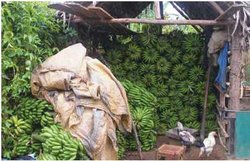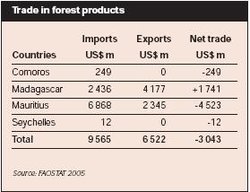Western Indian Ocean Islands and forests and woodlands
Contents
Introduction
Most of the WIO islands have humid tropical climates which are conducive to forest growth. However, the extent of closed canopy forest on the islands is limited due to population pressure, frequent cyclones and recurrent droughts, particularly in Madagascar and Mauritius. (Western Indian Ocean Islands and forests and woodlands)
Overview of resources
Table 1: Forest cover in the Western Indian Ocean island countries (Source: FAO) The major types of forests and woodlands on the islands include evergreen broadleaf rain forests, upper and lower montane forests, semi-evergreen moist forests, mangroves and savannah woodlands. Forest cover in the island states ranges from 66.7 percent in the Seychelles to 4.3 percent in the Comoros. Comoros has the highest rate of forest loss among the islands, which is largely attributed to charcoal making. Forest cover ranges from 20 percent in Madagascar, with 12 percent woodland, to about 4 percent in the Comoros, with 13 percent woodland. Charcoal making has been blamed for extensive deforestation in the Comoros. (Western Indian Ocean Islands and forests and woodlands)
Endowments and opportunities
Most of the forests and woodlands on the Western Indian Ocean islands have a high animal and plant species endemism, making them some of the world’s biodiversity hotspots. The Coco-de-Mer palm (Lodoicea maldivica) found on Praslin Island in the Seychelles is, for instance, endemic to this environment. The two remaining forest tracts of approximately 10 km2 on Anjouan island in the Comoros are home to the last surviving population of the Anjouan scops owl (Otus capnodes) and the Livingstone’s fruit bat (Pteropus livingstonii).
The forests and woodlands are also a source of various medicinal and ornamental plants, fruits, honey, essential oils, meat, and animal fodder.
Fuelwood is a vital resource for local communities, especially in countries such as the Comoros. Fruit farming in plantations and orchards is well developed in Madagascar, in terms of the volume and range of produce from fruit trees. This is less so in the other countries in the sub-region, but new developments are taking place in market gardening to open up new domestic and foreign trade across the sub-region. The produce includes fresh and dried fruit, fruit juice and tinned fruit. The intensity of commitment to fruit growing per thousand population varies between the countries, with the Comoros having 16 hectares (ha) of fruit trees per 1000 people, Madagascar 11 ha, Seychelles 5 ha, and Mauritius 1 ha. While trees bearing fruit have a growing potential for the future, the coconut industry is active in all countries in the region, and Madagascar also has a continuing commitment to coffee growing on a large scale.
There are also plans to establish national parks in the Karthala Mountain (2,361 metres high) on Grande Comore to strengthen the conservation status of the area. This will promote specialist ecotourism, and may help combat soil erosion and desertification of the island.
In the above respect, the Comoros has identified, mapped and is promoting 21 nature walks on the islands including 4 forest walks: La Forêt de la Grille, La Forêt Humide de Moheli, La Forêt Humide d’Anjouan, and Les Forêts Humides de Mayotte. The Seychelles has also opened a “green” hotline, for rapid public reporting of environmental contraventions, including the illegal felling of trees.
Although commercial timber production is now limited in most of the islands, Madagascar and Mauritius continue to enjoy a thriving export trade in industrial wood products. This trade is worth US$4,200 million in Madagascar and US$9,500 million in Mauritius. Table 2 shows the significance of trade.
Challenges faced in realizing opportunities for development
The WIO region experienced considerable deforestation in the 1990s. Forest area reduced from 13 million ha in 1990 to 11.9 million in 2002. The greatest loss in forest cover occurred in Madagascar, which contributed 99 percent of the total loss. The greatest percentage loss within countries, however, occurred in the Comoros with a reduction from 12,000 ha to 7,000 ha, a loss of 41 percent.
Two important causes of deforestation are frequent cyclones and droughts. During droughts, the risk of fire is also high. The major concern regarding forests is the high rate of deforestation and its environmental consequences such as soil erosion, desertification, and loss of ecosystem processes such as regulation of soil and water quality. In some countries, forests and woodlands are subjected to severe stress as a result of agricultural encroachment.
Strategies to improve opportunities
In view of the pressures on forests and woodlands in the WIO islands, a number of measures have been put in place to mitigate deforestation. They include promoting the integrated management of forests and woodlands through the establishment of Conservation Management Areas in Mauritius which are zones that have lately been infested with alien plant species. In pursuance of the desire to implement sustainable management of forests and forest resources, two countries, Mauritius and the Seychelles have joined the Dry Zone Africa process which aims at establishing criteria and indicators for sustainable forest management.
In addition to the above programmes, some countries, including the Comoros, have established programmes for the reforestation of previously logged areas. However, the speed and extent of reforestation has been slow. Through its FAO Plan of Action, the Food and Agriculture Organization (FAO) also intends to achieve sustainable management of the forest resources in the Small Island Developing States (SIDS) by establishing a holistic and integrated approach to the use of forest resources; promoting the rehabilitation and conservation of forest lands; enhancing coastal protection; promoting agroforestry systems; strengthening integrated planning; and developing ecotourism.
Further reading
- FAO, 2004. FAO and SIDS: challenges and emerging issues in agriculture, forestry and fisheries. Paper prepared by FAO on the occasion of the Inter-Regional Conference of Small Island Developing States, Bahamas, 26-30 January 2004. Food and Agriculture Organization of the United Nations, Rome.
- FAO, 2005. State of the World’s Forests 2005. Food and Agriculture Organization of the United Nations, Rome.
- Louette, M., Mieirte,D. and Jocque, R. (eds. 2004). La faune terrestre de l’archipel des Comores. Studies in Afrotropical Zoology No. 293. Musée royal de l’Afrique centrale, Tervuren.
- UNEP, 2002. African Environment Outlook: Past, Present and Future Perspectives. United Nations Environment Programme, Nairobi.
- UNEP, 2004. Africa Environment Outlook: Case Studies – Human Vulnerability to Environmental Change. United Nations Environment Programme, Nairobi.
- UNEP, 2006. Africa Environment Outlook 2
|
|
| Disclaimer: This article is taken wholly from, or contains information that was originally published by, the United Nations Environment Programme. Topic editors and authors for the Encyclopedia of Earth may have edited its content or added new information. The use of information from the United Nations Environment Programme should not be construed as support for or endorsement by that organization for any new information added by EoE personnel, or for any editing of the original content. |

